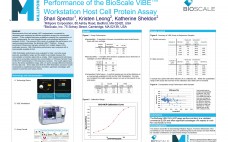Measurement of host cell protein (HCP) contaminants is essential for developing and monitoring an effective purification process for recombinant proteins. Of the multiple techniques available to quantify the concentrations of these contaminants, the most popular format uses polyclonal antisera in a sandwich ELISA. The purpose of this work is to evaluate the performance of a newly emerging technology; the BioScale ViBEâ„¢ Platform. Using an assortment of bioprocess samples selected from multiple stages of the purification process, ViBE Workstation performance was…
Tuesday, November 9, 2010 Daily Archives
Application of animal-free recombinant bioactive protein supplements to improve the performance of cell-based viral vaccine production
The development and regulatory approval of continuous cell lines for manufacturing viral vaccines has brought numerous benefits to production processes. We and others have contributed to upstream advances by improving cell culture media with the development of animal-free and chemically-defined recombinant protein supplements. The supplements developed include recombinant insulin-like growth factor-I (LONG®R3IGF-I), epidermal growth factor (LONG®EGF), transforming growth factor-α (LONG®TGF-α), transferrin (CellPrimeâ„¢ rTransferrin AF), and albumin (CellPrime â„¢rAlbumin AF-G or -S). Extensive literature on the action of these bioactive proteins…
Integrated clarification and product capture for high titer bioreactor harvests
Clarification and capture challenges are inherent in a new cell culture process that extends the exponential growth phase of mammalian cell cultures, resulting in high cell densities and product titers. Here, we show that second generation Expanded Bed Adsorption (EBA) technology is ideal for processing such high titer, high cell density harvests. In these culture harvests, viable cell densities of > 100 million cells/mL and product titers > 10 g/L are observed routinely, using standard media and cell lines. Several…



